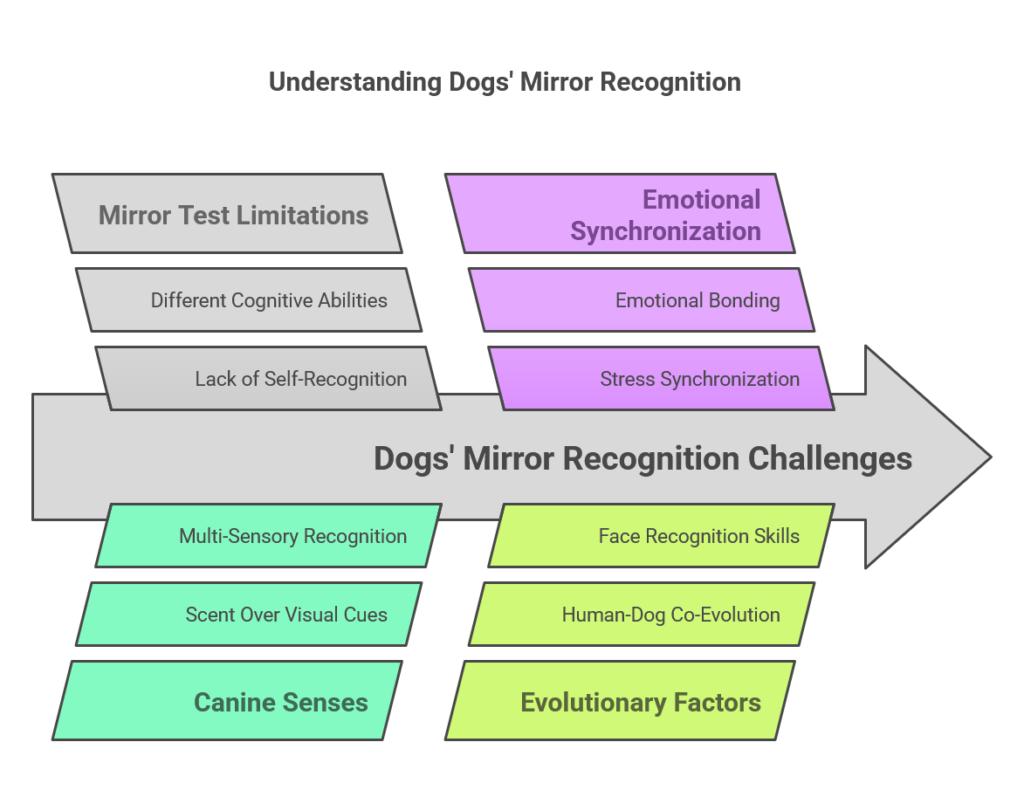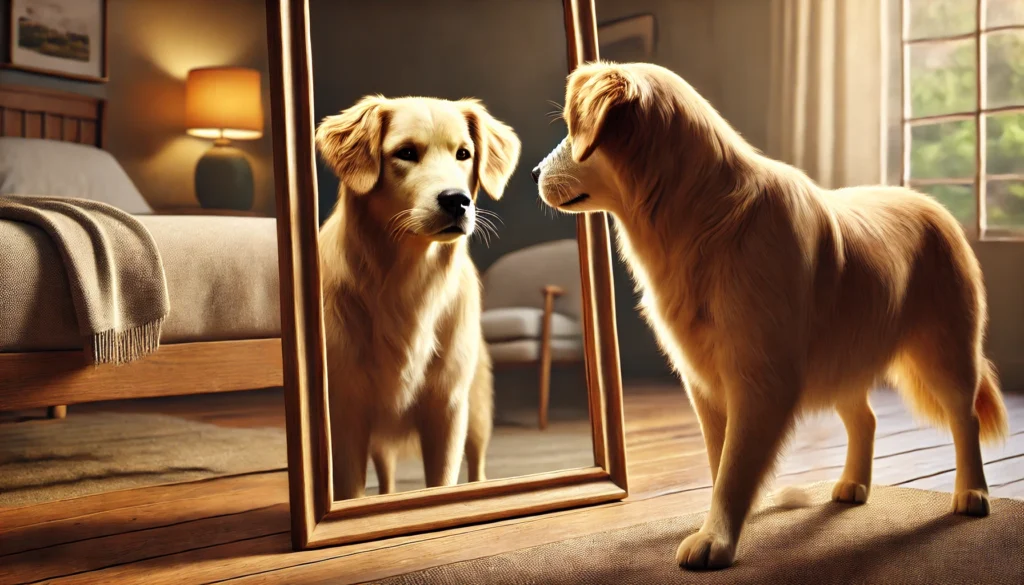Table of Contents
Introduction
A dog stands before a mirror, tilts its head, maybe barks or paws at the glass—and then, often, walks away as if nothing happened. Unlike humans, great apes, elephants, and even some birds, dogs generally fail the mirror test, a widely accepted method for assessing self-awareness in animals. But does that mean dogs lack the ability to recognize themselves or their owners in a reflection?
Dogs have evolved alongside humans for over 30,000 years (BBC), developing an extraordinary ability to recognize human faces, emotions, and even synchronize their stress levels with their owners. However, whether dogs recognize their owners in mirrors—or if they process reflections in a meaningful way—remains an open question.
In this article, we explore:
✔️ How the mirror test assesses self-recognition.
✔️ Whether dogs recognize their owners’ faces visually.
✔️ The role of scent and other senses in canine recognition.
✔️ Whether dogs’ ability to mirror emotions impacts their perception of reflections.
So, do dogs recognize their owners in the mirror? The answer isn’t as straightforward as you might think.
1. The Science of Self-Recognition in Animals
Self-recognition—the ability to recognize oneself as a distinct individual—has long been a focal point in comparative cognition. The mirror test, first developed by psychologist Gordon Gallup in 1970, involves placing a mark on an animal’s body in a location they can only see in a mirror. If the animal touches or investigates the mark while looking at its reflection, this suggests self-awareness (PubMed).
How Do Animals Perform on the Mirror Test?
Several species have demonstrated self-recognition, including:
- Great apes, such as chimpanzees and orangutans.
- Elephants, who use their trunks to examine marked areas on their bodies.
- Magpies, a bird species that can recognize their own reflection (Scientific American).
However, dogs fail the mirror test. When presented with their reflection, most dogs either ignore it or treat it as another animal before losing interest. Unlike primates, who rely heavily on vision, dogs primarily interpret the world through scent rather than sight. This suggests that the mirror test may not be a fair way to measure self-recognition in dogs.
Do Dogs Recognize Themselves in Other Ways?
Although they do not pass the mirror test, dogs recognize themselves through olfactory self-awareness. Research shows that dogs can distinguish their own scent from that of other dogs—something known as the “sniff test of self-recognition” (PMC). In experiments, dogs spent more time investigating scent samples from other dogs than their own, suggesting they can differentiate their own odor.
Thus, while dogs recognize themselves in terms of smell, visual self-awareness through mirrors remains uncertain. But what about recognizing their owners? Let’s explore how dogs perceive human faces.
2. Dogs and Human Facial Recognition: Do They Know Us?
While dogs may not identify their own reflection, research suggests they are highly adept at recognizing human faces. Dogs and humans share a unique bond, with dogs evolving specialized cognitive skills that help them interpret human emotions and social cues (PMC).
Dogs Recognize Familiar Faces
Unlike other domesticated animals, dogs recognize individual human faces and can differentiate between familiar and unfamiliar people. Studies show that:
- Dogs rely primarily on the eyes when distinguishing faces, similar to humans.
- They prefer looking at upright human faces over inverted ones, indicating a sophisticated visual processing ability.
- Even with changes in appearance (e.g., glasses, hats), dogs recognize their owners using subtle facial cues.
This ability is so advanced that dogs even distinguish between photographs of familiar and unfamiliar faces—though it remains unclear whether they associate these images with emotions or just recognize visual patterns (PMC).
How Dogs Use Faces to Make Decisions
Dogs not only recognize human faces but also use them to interpret emotions and adjust their behavior. Studies indicate that:
- Dogs react differently to happy, angry, and neutral expressions.
- They are more likely to approach a smiling face than a neutral or frowning one.
- Dogs may respond to visible teeth in a human smile as a positive cue—but whether this is an emotional response or a learned association remains debated (PMC).
So, dogs recognize human faces—but does this mean they recognize their owner’s reflection in a mirror? That’s where things get complicated.
3. Mirrors vs. Familiar Faces: How Dogs React to Reflections
If dogs recognize human faces so well, why don’t they seem to acknowledge their owners—or themselves—in a mirror? The answer lies in how dogs process sensory information.
How Dogs Typically Respond to Mirrors
Observations of canine behavior suggest that most dogs react in one of three ways when confronted with a mirror:
- Curiosity or playfulness – Some dogs initially paw, bark, or lunge at their reflection, treating it like another dog.
- Indifference – Many dogs quickly lose interest, possibly because the reflection lacks scent or interaction.
- Avoidance – A few dogs may act hesitant or wary, as if unsure of what the reflection represents.
Unlike primates, who understand that a mirror reflection corresponds to their own body, dogs recognize social cues primarily through smell, movement, and direct interaction—none of which a mirror provides.
Can Dogs Recognize Their Owners in the Mirror?
Research into canine cognition has not definitively shown whether dogs recognize their owners’ reflections as “real.” Some possibilities include:
- Dogs may perceive reflections as an optical illusion rather than a real presence.
- Unlike humans, dogs do not rely primarily on vision for recognition—if they can’t smell a person, they may not acknowledge their presence.
- Experiments with glass windows vs. mirrors suggest that while dogs react to a familiar person behind a window, their response to a mirror reflection is often muted (Scientific American).

Visual vs. Multi-Sensory Recognition
A 2019 study on comparative cognition found that dogs recognize their owners primarily through a combination of scent, voice, and movement patterns rather than static images or reflections (PMC). This means a dog might:
✔️ Respond to their owner’s reflection + voice but not to the reflection alone.
✔️ Recognize their owner through scent + vision more effectively than vision alone.
✔️ Be confused by a silent, scentless, still reflection, making mirrors an unreliable tool for recognition.
Thus, while dogs recognize their owners in real life using multiple cues, it remains unclear whether they can associate a mirror image with their human companion.
4. Mirroring and Emotional Synchronization: Recognizing More Than Just a Face
While mirrors may not be meaningful to dogs in a self-recognition sense, dogs are exceptionally skilled at mirroring human emotions—an ability that strengthens their bond with humans.
Dogs Mirror Human Emotions and Stress Levels
Research shows that dogs recognize and respond to their owners’ emotions in real-time. Studies indicate that:
- Dogs synchronize their stress levels with their owners, especially in long-term relationships (ScienceDaily).
- Owners with higher stress levels tend to have dogs with elevated stress hormones.
- The personality of the owner has a greater impact on a dog’s stress levels than the dog’s own temperament (PMC).
This synchronization extends beyond stress—dogs mirror their owners’ moods, becoming more relaxed around calm owners and more anxious around stressed ones.
How Does This Relate to Mirror Recognition?
Even if dogs don’t grasp the concept of their own reflection, they might:
✔️ Recognize their owner’s reflection as familiar but respond emotionally rather than cognitively.
✔️ Associate the mirror with a social presence, adjusting their behavior subtly.
✔️ React to an owner’s reflection differently than a stranger’s, even if the response is subconscious.
This raises the question: Do dogs react differently when their owner appears in a mirror versus in real life? While research is ongoing, current findings suggest that dogs recognize their owners’ presence through movement, scent, and emotion—factors a mirror does not provide.

5. Beyond the Mirror: How Dogs Recognize Their Owners in the Real World
Dogs may not rely on mirrors for recognition, but they excel at identifying their owners through a combination of sensory cues.
1. Scent Recognition: The Primary Identifier
Dogs recognize their owners first and foremost by smell. In fact, scent is so crucial that:
- Dogs can detect their owner’s scent even after long periods of separation (PMC).
- In experiments, dogs consistently prefer objects containing their owner’s scent over those belonging to strangers.
- A 2015 fMRI study showed that the scent of a familiar human activates the reward center in a dog’s brain more than any other stimulus.
2. Voice Recognition: Distinguishing Familiar Sounds
Dogs recognize their owners’ voices even in a crowded environment. Research confirms that:
✔️ Dogs can differentiate between their owner’s voice and a stranger’s, even when both say the same words.
✔️ They respond more attentively to their owner’s tone, pitch, and rhythm than to other voices.
✔️ Some breeds—particularly working dogs—are highly attuned to vocal cues, enhancing recognition (PMC).
3. Behavioral Recognition: Learning Human Cues
Dogs don’t just recognize their owners visually—they remember behavioral patterns, including:
- Gait and posture – Dogs identify people based on how they move.
- Daily routines – Dogs anticipate their owner’s actions based on repeated behaviors.
- Emotional energy – Dogs recognize shifts in their owner’s mood and body language.
So, Why Don’t Dogs React to Mirrors Like Humans Do?
- A reflection lacks scent, movement, and sound, making it an incomplete representation.
- Dogs recognize individuals using a mix of senses, not vision alone.
- The brain’s reward system is more activated by scent than by sight, making reflections less meaningful.
The Verdict: Can Dogs Recognize Their Owners in the Mirror?
While dogs recognize their owners in many ways, mirrors may not provide the cues needed for true recognition. Instead, dogs rely on a sophisticated blend of scent, sound, movement, and emotion to identify familiar humans.

Conclusion: Do Dogs Recognize Their Owners in the Mirror?
The question of whether dogs recognize their owners in mirrors does not have a simple yes-or-no answer. While dogs are incredibly skilled at recognizing humans through scent, voice, and behavior, their reaction to reflections suggests that mirrors do not provide enough sensory information for true recognition.
Studies have consistently shown that:
✔️ Dogs recognize familiar human faces, using subtle visual cues.
✔️ Dogs synchronize their emotions with their owners, responding to stress and mood changes.
✔️ Dogs rely on scent more than vision for identification, which mirrors do not provide.
✔️ Dogs respond to reflections, but not in a way that confirms self-awareness or recognition of others.
So, while your dog knows you deeply, they may not recognize your reflection as you. Instead, they recognize your presence through a combination of smell, voice, and movement, proving that their bond with humans goes far beyond mere visual recognition.
FAQs:
1. Why don’t dogs react to mirrors like humans do?
Unlike humans, dogs don’t rely primarily on vision to recognize people. Since mirrors lack scent, movement, and sound—three key elements dogs use for recognition—they often ignore reflections altogether.
2. Can dogs recognize their own reflection?
Most evidence suggests they do not. Unlike primates, elephants, and some birds, dogs fail the mirror test, which is used to assess self-awareness. However, dogs recognize themselves through scent-based experiments, indicating a different form of self-awareness.
3. Do some dogs recognize their owners in mirrors more than others?
There’s no conclusive evidence, but it’s possible that some breeds—particularly those bred for visual tracking (e.g., Border Collies, Greyhounds)—may pay more attention to reflections than scent-focused breeds like Bloodhounds.
4. If my dog barks at the mirror, does that mean they recognize me?
Not necessarily. Dogs may react to reflections out of curiosity, confusion, or playfulness, but this doesn’t mean they recognize the image as their owner. Instead, they may interpret it as another dog or an unfamiliar presence.
5. Can training help dogs understand mirrors?
While training can help dogs associate mirrors with specific cues, it’s unlikely to change their fundamental perception of reflections. They might learn that a mirror shows something familiar, but that doesn’t mean they recognize the reflection as a true representation of themselves or their owner.
6. How do dogs recognize their owners in real life?
Dogs recognize their owners through multiple sensory cues, including:
✔️ Scent – The strongest recognition factor, even at a distance.
✔️ Voice – Dogs distinguish familiar voices from strangers.
✔️ Body language and movement – Dogs remember and respond to familiar postures and gaits.
✔️ Facial recognition – While secondary to scent and sound, dogs can recognize human faces.
7. Do mirrors confuse dogs?
Not necessarily. Some dogs investigate their reflection briefly, but most lose interest quickly. This suggests they either don’t recognize the reflection as a living being, or they simply find it irrelevant to their daily experiences.
8. Could future research change our understanding of how dogs recognize reflections?
Possibly! Future studies might explore:
- Whether certain breeds or training methods improve mirror recognition.
- If dogs process reflections differently when paired with scent cues.
- How dogs’ cognitive abilities compare to other species that pass the mirror test.
For now, though, your dog isn’t ignoring your reflection out of confusion—they just know you better through scent, sound, and the deep emotional bond you share.




